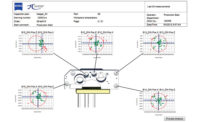COLUMBIA, MD-The combined Credit Managers’ Index (CMI) for September rose to 49.8, bouncing back from a nearly stagnant August on the strength of some dramatic improvements in dollar collections and in reductions in accounts placed for collection and dollar amount beyond terms. September saw the biggest improvement in these sectors in almost a year and that bodes very well for this quarter. Throughout the last year, the most distressing numbers seemed to be in these categories, which is expected in the middle of a recession. Even companies surviving the downturn were likely falling behind in bills or choosing to delay payments in an attempt to preserve cash flow. Now there is some sense that customers are starting to catch up and get current with their creditors.
The rate of dollar collections has not been this positive since September 2008, just as the economy started to seriously bottom out. The number of accounts placed for collection has declined and is lower than any point since last summer. Dollar exposure is also the lowest since summer 2008. These index readings suggest that there is a marked improvement in credit performance. “In order for the CMI to move into expansion territory-above 50-it will take the coalescing of three trends in credit: more credit availability, more sales that require the acquisition of credit and more prompt and regular payments on credit granted,” says Dr. Chris Kuehl, the National Association of Credit Management's (NACM) economic analyst. “There has been some movement in sales and some positive movement in terms of credit availability, but up to this point there hadn’t really been positive news regarding payment on that debt. Now all three factors seem to be moving in a generally positive direction.”
This development is consistent with some of the general economic observations made over the last few weeks. The Federal Reserve’s Open Market Committee (OMC) made it clear that they thought the recession had reached an end and that the focus could now shift to recovery. Although recent Conference Board data showed a reduction in consumer optimism, a recovery of some consumer confidence as reported by the University of Michigan may have influenced the OMC opinion. There has also been good news in the housing sector in addition to data showing that some manufacturing industries have started to grow. Still, there remains plenty to worry about: from high unemployment to the state of commercial realty to future threats of inflation.
The CMI was expected to crest 50 in this month’s survey, but the availability of credit was not quite what was hoped and the final number was just a fraction under the point that signals expansion. With the combined index now at 49.8, Kuehl is confident that the fabled 50 point will be reached and reported in October’s survey.
Manufacturing sector data mirrored improvements in the combined index despite the lack of an overt sign that sector conditions have improved much in the last few weeks. At this point, the evidence is somewhat anecdotal, but reports coming from a wide variety of manufacturing sectors suggest there has been improvement from just the end of August to October 1.
A look at the CMI data supports these rumors in so far as there has been a major drop in dollar exposure and a very dramatic decline in the number of bankruptcies. The peak for closure in the manufacturing sector seems to have taken place at the beginning of the year-from January to March. The major improvement in September is attributed to the fact that those that have survived thus far are probably going to make it through to the recovery.
The positive factors for manufacturing were flat this month. Improvement in sales, credit availability and dollar collections were very marginal, but this was not what moved the index back into more positive territory. Rather, it was the improvement in credit performance, which indicates that companies are getting back in their creditors’ good graces.
“Even though the manufacturing index registered very close to the combined index at 49.6, the improvements were a little different than those in the combined index. While the CMI was primarily driven by some positive factors, the reduction of some negative factors had a greater influence on the manufacturing index,” says Kuehl. “Given the horrific year that manufacturers have been through, it is more than encouraging to note that bankruptcies and delinquencies are ebbing and that credit is getting back in shape after the long period of decline.”
The year-over-year comparison of September 2009 vs. September 2008 is starting to look very promising and will remain so for the next few months. This is the period in which the most recent gains will be compared to the beginnings of the collapse. As can be seen, the service sector is starting to accelerate past the manufacturing sector on the basis of more sales and more credit access, but the combined CMI is now poised to crest 50 at any moment. In the coming months, it will be readily apparent that this is a recovery period, which will contrast dramatically with what took place in the latter part of 2008.
This report, complete with tables and graphs, and the CMI archives may be viewed athttp://web.nacm.org/cmi/cmi.asp.
Get our new eMagazine delivered to your inbox every month.
Stay in the know with Quality’s comprehensive coverage of the manufacturing and metrology industries.
SIGN UP TODAY!Copyright ©2024. All Rights Reserved BNP Media.
Design, CMS, Hosting & Web Development :: ePublishing


